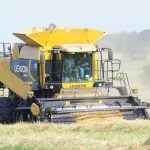Xiaobin Wu has a culinary dilemma to ponder as he walks to the grocery store from his home in the eastern Chinese province of Shandong – pizza pops or rice?
“My family is a very typical Chinese family,” he says.
“(But) my son, he is 10 years old now, is a surprise to me. He loves pizza. He loves spaghetti. My son likes any food that has cheese on it.”
Wu, a director at the milling company Xinyan Foods, was in Canada in late May for a two-week program with the Canadian International Grain Institute (CIGI). He was one of 25 participants in CIGI’s annual international grain industry program, which ran from late May to the middle of June.
Read Also

Storm dynamics and extreme rainfall
Besides moisture, instability and orographic lift, the next biggest factor that contributes to heavy or extreme rainfall is storm dynamics.
The program introduces grain industry representatives from around the world to the Canadian grain system. It began this year in Winnipeg with stops at the Canadian Wheat Board, the Canadian Malting Barley Technical Centre and a Manitoba farm. It also included a train ride across the Prairies, ending with a tour of a terminal elevator in Vancouver.
Before departing Winnipeg, Wu said his son’s affection for all things cheesy represents a broader change in Chinese tastes over the last decade.
He said Xinyan Foods produced only all-purpose flour 20 years ago, but the milling company has been forced to change its product line in recent years. Xinyan now buys Canadian wheat to match modern appetites.
“In China, more and more people, especially young people, they are eating hamburgers, hot dogs and steak …. They are not sticking to traditional Chinese food,” he said.
“Today, over 50 percent of our product goes to high-end customers (that require premium flour). Chinese people are now willing to pay for a better product.”
While the shift in eating habits is not as dramatic in South Africa, Quentin van der Linde said he is also noticing a trend. The food market is becoming two distinct markets, he added.
“With bread and fast food products like buns, the consumption is going up,” said van der Linde, a procurement co-ordinator with Premier Foods, the largest baking company in South Africa.
“But people are becoming health conscious and they want a natural product. So that market is also growing, so you’ve got these two sectors … quite opposite, but you’ve got to look at both.”
Wu, who was visiting Canada for the first time, said he particularly noticed the scale of Canadian farms.
“A farmer we visited last week … that family can take care of 3,000 acres,” he said.
“I think this is a thousand times as much as a farmer in China.”















